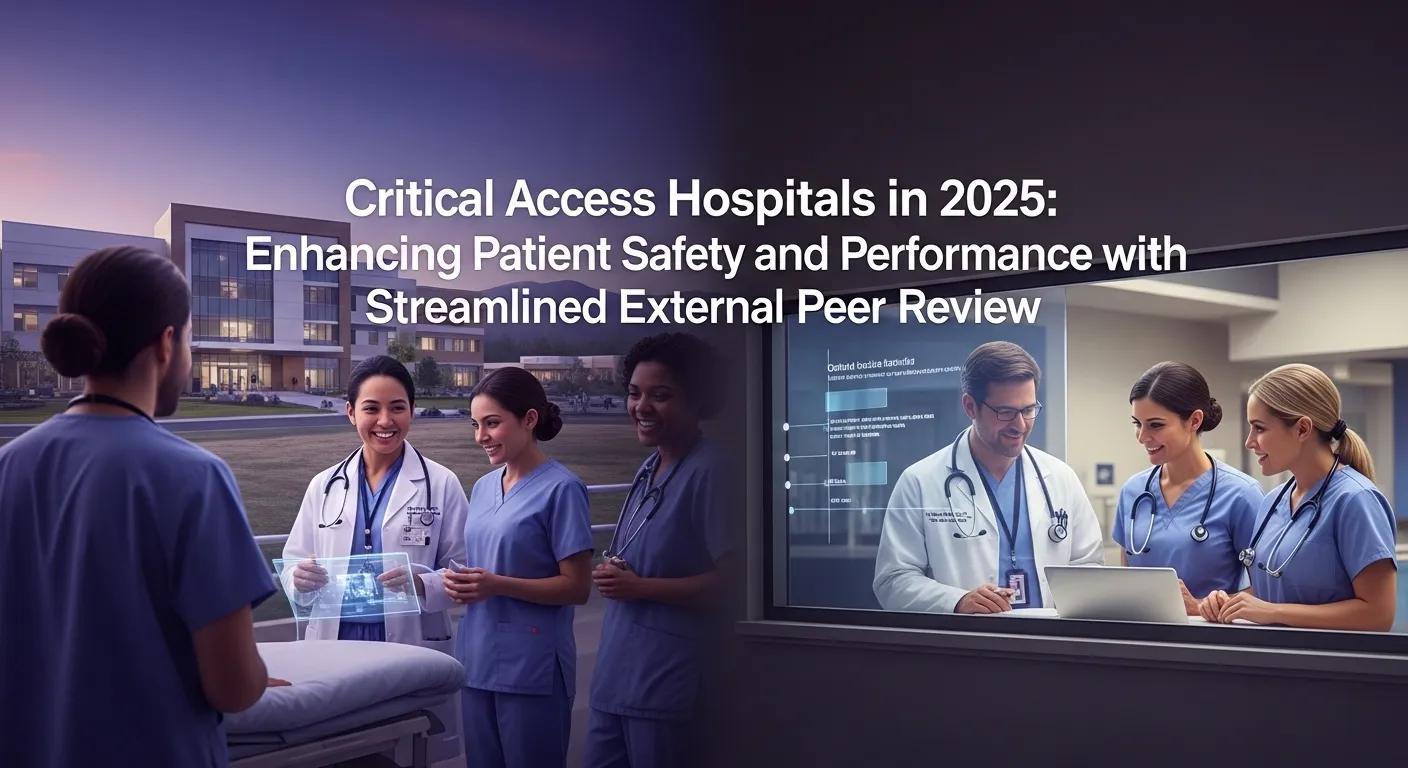

The New Era of Telehealth: Ensuring Quality and Compliance in Rural Virtual Care Through External Peer Review
External peer review is vital for ensuring quality and compliance in rural telehealth. It mitigates bias, fills specialty gaps, reduces administrative burden, and strengthens compliance for FQHCs and CAHs.
Telehealth has revolutionized healthcare access, particularly for rural communities. It connects patients to vital services previously out of reach, bridging geographical gaps with innovative virtual care. However, this rapid expansion brings a critical challenge for healthcare leaders: how to ensure the highest quality of care and maintain robust compliance standards in a constantly evolving virtual landscape. The answer lies in adopting a strategic approach to peer review, one that leverages external expertise to fortify your virtual care infrastructure.
The Unique Challenges of Telehealth in Rural Settings
Bridging Gaps, Introducing Complexities
While telehealth dramatically improves access for FQHCs and CAHs serving rural populations, it also introduces new complexities. Virtual consultations require distinct documentation, communication protocols, and technological competencies. Ensuring consistent quality across diverse virtual encounters demands rigorous oversight that many traditional internal peer review processes struggle to provide.
Staffing and Specialty Shortages Magnified
Rural health centers often face chronic shortages of qualified healthcare professionals. This scarcity extends to finding internal reviewers with the specific expertise needed for complex telehealth cases—especially when dealing with subspecialties like tele-psychiatry, virtual dermatology, or other niche areas. Expecting already stretched staff to adequately review peers with highly specialized virtual care skills is often unrealistic and unsustainable.
Why Traditional Peer Review Falls Short in a Virtual World
The Pitfalls of Internal Bias
In smaller, closely-knit health center teams, internal peer reviews can inadvertently suffer from bias or perceived conflicts of interest. Objectivity can be compromised, leading to reviews that lack the necessary rigor and impartiality. This can undermine trust, reduce the defensibility of findings, and ultimately hinder true quality improvement.
Lack of Subspecialty Expertise
A significant challenge in telehealth is the breadth of services offered. An internal reviewer might be excellent in general practice, but lack the nuanced understanding required to effectively review a tele-nephrology case or a complex virtual behavioral health intervention. This gap in subspecialty-matched reviewers can lead to superficial assessments and missed opportunities for critical feedback.
Administrative Burden on Overstretched Teams
Managing an internal peer review program is administratively heavy. It requires significant time, coordination, and resources to schedule, conduct, and document reviews. For FQHCs, CAHs, and other health centers already navigating a myriad of operational demands, this administrative overload can divert valuable staff time from patient care and other essential functions.
External Peer Review: A Strategic Imperative for Telehealth Quality
Embracing external peer review for telehealth offers a powerful solution, transforming a compliance requirement into a strategic advantage.
- Objective Expertise, Unbiased Insights: External reviewers bring an impartial perspective and deep subspecialty knowledge, ensuring that every telehealth case is evaluated against the highest standards of care. This objectivity is crucial for building a strong foundation of quality in your virtual services.
- Streamlined Compliance and Reduced Risk: Expert external reviews help your organization navigate the complex regulatory landscape of telehealth. This proactive approach strengthens your position for crucial site visits and audits from bodies like HRSA, TJC, and CMS, reducing legal and compliance risks. The documentation generated shows diligence and excellence.
- Enhancing Provider Satisfaction and Retention: Providers are more likely to engage positively with peer review feedback when it comes from highly qualified, unbiased external peers. High-quality reviews provide constructive insights, foster professional growth, and ultimately contribute to higher provider satisfaction and retention rates.
- Data-Driven Improvements and Strategic Advantage: Medplace reports offer clear, actionable insights through yes/no/NA scorecards, deficiency comments, overall summaries, and targeted action plans. These peer review metrics can be leveraged for quality improvement initiatives, grant applications, and internal dashboards, showcasing your commitment to excellence and improving your competitiveness.
Medplace: Your Partner in Telehealth Quality Assurance
Medplace understands the unique needs of FQHCs, CAHs, and health centers. Our external peer review services are designed to overcome the common pain points of internal processes. We provide:
- Objective, Specialty-Matched Reviewers: Access to a vast network of subspecialists ensures expert evaluation for every telehealth case.
- Digitally Streamlined Systems: Our platform significantly reduces administrative burden, speeding up review results with a typical turnaround of less than two weeks.
- Proactive, Pattern-Based Insights: Our reviews focus on identifying patterns and preventing future issues, not just reacting to incidents.
- Justifiable ROI: Our ROI Calculator helps you demonstrate the financial benefits of external peer review to leadership and finance teams, making a compelling case for investment.
Conclusion
The new era of telehealth demands a new approach to quality and compliance. By embracing external peer review, particularly for the unique challenges of rural virtual care, healthcare leaders can ensure high-quality, objective oversight. This strategic shift not only safeguards your organization against compliance risks but also fosters provider excellence, improves patient outcomes, and positions your health center for continued success in the evolving landscape of virtual care. Partner with Medplace to transform your peer review process into a powerful asset for your telehealth services.

Critical Access Hospitals in 2025: Enhancing Patient Safety and Performance with Streamlined External Peer Review
CAHs face unique peer review challenges. External services like Medplace offer objective expertise, streamline compliance, and boost patient safety, provider satisfaction, and grant competitiveness.
.png)
.png)

Mitigating Risk in Tribal Health: Proactive Patient Safety with Culturally Competent External Peer Review
External peer review offers Tribal Health Organizations unbiased, culturally competent assessments, reducing administrative burden, improving patient safety, and strengthening compliance documentation.
.png)
.png)

Value-Based Care for FQHCs: How External Peer Review Drives Better Outcomes and Sustainable Revenue
Medplace external peer review helps FQHCs thrive in value-based care. Gain objective insights, cut compliance risk, reduce admin burden, and boost quality, provider satisfaction, & revenue.
.png)
.png)



.png)
.png)
.png)


.png)




.png)